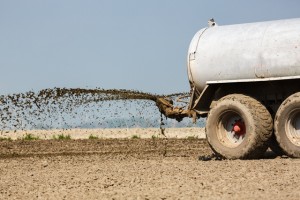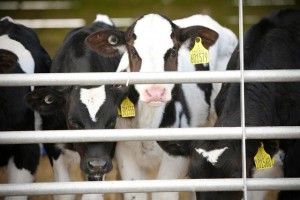

Cryptosporidium species are protozoan parasites closely related to the coccidia. One major species, Cryptosporidium parvum, infects both farm animals and humans, with another species, Cryptosporidium andersoni, currently restricted to adult cattle. The oocysts of C. parvum are so small that their association with acute diarrhoea was never suspected until the 1970s, when specific biological staining methods confirmed their presence in the diarrhoea.
Cryptosporidiosis is widespread throughout the world. In Switzerland Cryptosporidium has been shown to be the most commonly detected (53.7%) of the four major enteropathogens (rotavirus, bovine coronavirus, enterotoxigenic Escherichia coli) that cause neonatal diarrhoea found in young diarrhoeic calves. A study conducted in Cheshire, UK, reported a prevalence of Cryptosporidium as 28% in unweaned calves. This is lower than a study of diarrhoeic calves in France where 43% of calves were also excreting cryptosporidia. C. parvum has been found in both diarrhoeic and normal calves with the prevalence ranging between 5% and 50% in calves aged between 7-84 days old across all seasons. Shedding of C. parvum has been reported to peak in calves aged 1-3 weeks old, particularly at around 12 days old with herd prevalence peaking in the winter.
Cryptosporidium lifecycle
C. parvum has a rapid, direct life cycle and infection occurs when viable oocysts in the environment are ingested by susceptible hosts, usually young stock under a month old.
- The oocysts excyst (break open) in the gut releasing four infective parasites (sporozoites)
- The sporozoites penetrate the cells lining the small intestine and develop just below the cell membrane
- Here the parasites undergo at least two stages of asexual reproduction, then differentiate into sexual forms, which fuse to form oocysts
- The oocysts mature on the gut wall and are shed in the faeces as fully developed, infective oocysts
Cryptosporidium oocysts are infective as soon as they pass into the environment and infection soon reaches a high level and spreads very rapidly.
Fresh slurries can contain a large amount of oocysts (cryptosporidium eggs) and can be spread onto the land. Ammonia from slurry will kill the oocysts when stored for a few days.
Oocysts can survive for many months under favourable conditions (cool and moist). Fresh farmyard manure (FYM) and slurries can contain large numbers of oocysts, and when spread on land will pose an environmental contamination risk to both humans and animals. The heat generated during composting will kill the majority of oocysts, as will the ammonia generated by cattle slurry during storage. Exposure of oocysts to temperatures of >55ºC for 15 days in windrow compost heaps appears to be effective in inactivation. However, the duration of time taken to kill off oocyts in compost is longer than that required to kill bacteria. The largest threat of environmental contamination comes from fresh faeces washed down drains from farm yards and dairy parlours or deposited on pastures close to watercourses. The risk of disease entry to a farm from feed contaminated with oocysts from wildlife excreta should also be considered. Daniels and colleagues modelled the infectious probabilities from wild rodents and bird faeces and determined that ingestion of feed contaminated with wildlife faeces could account for the prevalence of Cryptosporidium infection in sheep and cattle in Scotland.
Animals show an age-related susceptibility to infection, so the older the animal at the time of infection, the less severe the clinical symptoms are likely to be. Immunity is acquired so infections in adult animals are asymptomatic, and the numbers of oocysts shed are usually small. An infected dam can act as a reservoir of infection for her offspring, although there is variable evidence of a periparturient rise in oocyst shedding as some studies have shown no increase, whereas others have reported an increase in shedding . Infections in farm cats, and dogs are also asymptomatic, but these animals may also act as a reservoir.
As Cryptosporidium lacks host specificity among mammals, humans can also become infected. The recent increase in popularity of farm parks for recreational visits has led to a number of outbreaks, particularly where the opportunity exists for members of the public to feed or have direct contact with young animals.
Clinical signs of Cryptosporidium Infection
Clinical symptoms occur 3-7 days after infection and include a profuse watery diarrhoea, inappetance, gastrointestinal discomfort, abdominal tension, nausea and a mild fever. The onset of clinical signs coincides with the shedding of oocysts in the dung. Severe infections may lead to dehydration. Calves, while becoming depressed and experiencing severe diarrhoea, often continue to feed quite well during infection. Mortality rates are usually low. However, oocyst shedding often continues after the clinical signs have disappeared.
Control and Prevention of Cryptosporidiosis
All bought-in stock should be quarantined and observed for scours. Any animals scouring need to be kept in isolation until the scouring stops.
As infections are initiated by ingestion of oocysts, control strategies must be aimed at reducing the number of oocysts in the environment.
Any bought-in animals should be quarantined for at least 7 days to see if scouring occurs. Any scouring animals should be kept in isolation, which should continue for at least one week after the diarrhoea has ceased.
Cows about to give birth should be cleaned of faecal contamination, and their teats should be clean. Ensure all new-born calves receive sufficient colostrum. Known infected calves should be handled after handling the healthy stock.
Where possible, an ‘all in all out’ house policy should be employed, so that pens and equipment can be steam cleaned or treated with an appropriate disinfectant. The pens should be liberally bedded with straw.
The housing area should be cleaned and disinfected annually following turnout to grass. Since temperatures above 60° C inactivate oocysts, steam cleaning can be an effective way of sterilizing the building, pens and feeding troughs.
In farms where cryptosporidiosis is known to be a problem, halofuginone lactate (Halocur, MSD Animal Health) can be used as a preventive measure. This is not a treatment, but acts to reduce the excretion of oocysts from infected calves and can reduce the clinical severity of infection. Dosing is by oral administration after feed and must be continued for 7 consecutive days. This can be undertaken either as a prophylactic preventive measure on infected farms to reduce oocyst excretion, where all calves are treated starting at 24-48 hours old. Alternatively, it can be used in the face of an outbreak to reduce the excretion of oocysts and the severity of clinical disease, where calves are treated within 24 hours of the onset of diarrhoea.
Treating Cryptosporidium Infection
In otherwise healthy calves, the diarrhoea will usually resolve without intervention after 4-7 days. No licensed effective chemotherapeutic agents or vaccines are available to treat Cryptosporidium infections, but halofuginone has been shown to reduce the severity of diarrhoea and limits the spread. Supportive therapy may be in the form of oral rehydration with a proprietary electrolyte solution.
The affected animals should be housed and infected neonates protected from chilling. The infected calves may require considerable encouragement to drink for several days. A small volume of electrolytes offered frequently is the best course of action to follow.
Good Practice based on Current Knowledge
- Lower stocking rates will can reduce risk of infection spread
- Quarantine bought-in animals for at least 7 days.
- Keep any scouring animals in isolation until one week after the diarrhoea has ceased
- Ensure late-pregnant cows and their teats are clean
- Ensure all new-born calves receive sufficient colostrum
- Known infected calves should be handled after handling the healthy stock
- If possible, an ‘all in all out’ house policy should be employed with steam cleaning between batches
- Steam clean the housing area annually following turnout to grass
- Keep feed stores secure from wildlife
- Give sick calves supportive therapy by oral rehydration with a proprietary electrolyte solution
- Encourage the affected animal to drink by frequently offering it a small volume of electrolytes
- House the affected animals
- Protect infected neonates from chilling
- Remember that cryptosporidiosis is potentially a zoonotic disease and all farm staff and visitors should follow hygienic precautions


 Contact Jaguza Support
Contact Jaguza Support